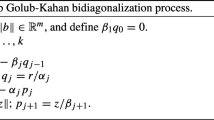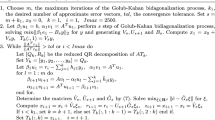Abstract
LSQR, a Lanczos bidiagonalization based Krylov subspace iterative method, and its mathematically equivalent conjugate gradient for least squares problems (CGLS) applied to normal equations system, are commonly used for large-scale discrete ill-posed problems. It is well known that LSQR and CGLS have regularizing effects, where the number of iterations plays the role of the regularization parameter. However, it has long been unknown whether the regularizing effects are good enough to find best possible regularized solutions. Here a best possible regularized solution means that it is at least as accurate as the best regularized solution obtained by the truncated singular value decomposition (TSVD) method. We establish bounds for the distance between the k-dimensional Krylov subspace and the k-dimensional dominant right singular space. They show that the Krylov subspace captures the dominant right singular space better for severely and moderately ill-posed problems than for mildly ill-posed problems. Our general conclusions are that LSQR has better regularizing effects for the first two kinds of problems than for the third kind, and a hybrid LSQR with additional regularization is generally needed for mildly ill-posed problems. Exploiting the established bounds, we derive an estimate for the accuracy of the rank k approximation generated by Lanczos bidiagonalization. Numerical experiments illustrate that the regularizing effects of LSQR are good enough to compute best possible regularized solutions for severely and moderately ill-posed problems, stronger than our theory predicts, but they are not for mildly ill-posed problems and additional regularization is needed.
Similar content being viewed by others
References
Bauer F, Lukas M A. Comparing parameter choice for regularization of ill-posed problems. Math Comput Simul, 2011, 81: 1795–1841
Bazán F S V, Borges L S. GKB-FP: An algorithm for large-scale discrete ill-posed problems. BIT Numer Math, 2010, 50: 481–507
Bazán F S V, Cunha M C C, Borges L S. Extension of GKB-FP algorithm to large-scale general-form Tikhonov regularization. Numer Linear Algebra Appl, 2014, 21: 316–339
Bergou E H, Gratton S, Tshimanga J. The exact condition number of the truncated singular value solution of a linear ill-posed problem. SIAM J Matrix Anal Appl, 2014, 35: 1073–1085
Björck Å. A bidiagonalization algorithm for solving large and sparse ill-posed systems of linear equations. BIT Numer Math, 1988, 28: 659–670
Björck Å. Numerical Methods for Least Squares Problems. Philadelphia: SIAM, 1996
Calvetti D, Golub G H, Reichel L. Estimation of the L-curve via Lanczos bidiagonalization. BIT Numer Math, 1999, 39: 603–619
Calvetti D, Hansen P C, Reichel L. L-curve curvature bounds via Lanczos bidiagonalization. Electron Trans Numer Anal, 2002, 14: 20–35
Calvetti D, Lewis B, Reichel L. On the choice of subspace for iterative methods for linear ill-posed problems. Int J Appl Math Comput Sci, 2001, 11: 1069–1092
Calvetti D, Lewis B, Reichel L. GMRES, L-curve, and discrete ill-posed problems. BIT Numer Math, 2002, 42: 44–65
Calvetti D, Morigi S, Reichel L, et al. Tikhonov regularization and the L-curve for large discrete ill-posed problems. J Comput Appl Math, 2000, 123: 423–446
Calvetti D, Reichel L. Tikhonov regularization of large linear problems. BIT Numer Math, 2003, 43: 263–283
Chung J, Nagy J G, O’Leary D P. A weighted GCV method for Lanczos hybrid regularization. Electron Trans Numer Anal, 2008, 28: 149–167
Engl H W, Hanke M, Neubauer A. Regularization of Inverse Problems. Dordrecht: Kluwer, 1996
Gazzola S. Regularization techniques based on Krylov methods for ill-posed linear systems. PhD Thesis. Padua: University of Padua, 2014
Gazzola S, Novati P. Multi-parameter Arnoldi-Tikhonov methods. Electron Trans Numer Anal, 2013, 40: 452–475
Gazzola S, Novati P, Russo M R. On Krylov projection methods and Tikhonov regularization. Electron Trans Numer Anal, 2015, 44: 83–123
Hanke M. Conjugate Gradient Type Methods for Ill-Posed Problems. Essex: Longman, 1995
Hanke M. On Lanczos based methods for the regularization of discrete ill-posed problems. BIT Numer Math, 2001, 41: 1008–1018
Hansen P C. Rank-Deficient and Discrete Ill-Posed Problems: Numerical Aspects of Linear Inversion. Philadelphia: SIAM, 1998
Hansen P C. Regularization tools version 4.0 for Matlab 7.3. Numer Algor, 2007, 46: 189–194
Hansen P C. Discrete Inverse Problems: Insight and Algorithms. Philadelphia: SIAM, 2010
Hnetynková I, Plešinger M, Strakoš Z. The regularizing effect of the Golub-Kahan iterative bidiagonalization and revealing the noise level in the data. BIT Numer Math, 2009, 49: 669–696
Hofmann B. Regularization for Applied Inverse and Ill-posed Problems. Stuttgart: Teubner, 1986
Jensen T K, Hansen P C. Iterative regularization with minimum-residual methods. BIT Numer Math, 2007, 47: 103–120
Jia Z, Niu D. An implicitly restarted refined bidiagonalization Lanczos method for computing a partial singular value decomposition. SIAM J Matrix Anal Appl, 2003, 25: 246–265
Kilmer M E, O’Leary D P. Choosing regularization parameters in iterative methods for ill-posed problems. SIAM J Matrix Anal Appl, 2001, 22: 1204–1221
Lewis B, Reichel L. Arnoldi-Tikhonov regularization methods. J Comput Appl Math, 2009, 226: 92–102
Li Z C, Huang H T, Wei Y M. Ill-conditioning of the truncated singular value decomposition, Tikhonov regularization and their applications to numerical partial differential equations. Numer Linear Algebra Appl, 2011, 18: 205–221
Neuman A, Reichel L, Sadok H. Algorithms for range restricted iterative methods for linear dicrete ill-posed problems. Numer Algor, 2012, 59: 325–331
Novati P, Russo M R. A GCV based Arnoldi-Tikhonov regularization method. BIT Numer Math, 2014, 54: 501–521
O’Leary D P, Simmons J A. A bidiagonalization-regularization procedure for large scale discretizations of ill-posed problems. SIAM J Sci Statist Comput, 1981, 2: 474–489
Paige C C, Saunders M A. LSQR: An algorithm for sparse linear equations and sparse least squares. ACM Trans Math Soft, 1982, 8: 43–71
Parlett B N. The Symmetric Eigenvalue Problem. Philedaphia: SIAM, 1998
Reichel L, Rodriguez G. Old and new parameter choice rules for discrete ill-posed problems. Numer Algor, 2013, 63: 65–87
Stewart G W. Matrix Algorithms, vol. II: Eigensystems. Philadelphia: SIAM, 2001
Vogel C R. Computational Methods for Inverse Problems. Philadelphia: SIAM, 2002
Acknowledgements
This work was supported by National Basic Research Program of China (Grant No. 2011CB302400) and National Natural Science Foundation of China (Grant No. 11371219). The authors thank the referees for their valuable suggestions and comments, which made the authors think over numerous issues deeply and improve the presentation of the paper considerably.
Author information
Authors and Affiliations
Corresponding author
Rights and permissions
About this article
Cite this article
Huang, Y., Jia, Z. Some results on the regularization of LSQR for large-scale discrete ill-posed problems. Sci. China Math. 60, 701–718 (2017). https://doi.org/10.1007/s11425-015-0568-4
Received:
Accepted:
Published:
Issue Date:
DOI: https://doi.org/10.1007/s11425-015-0568-4




